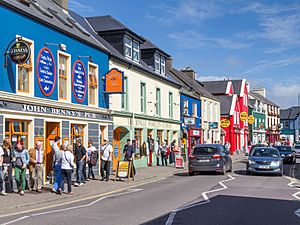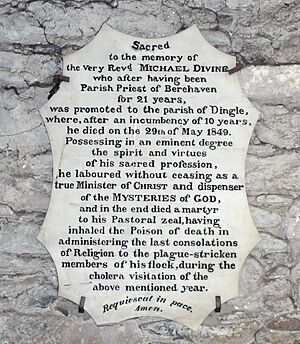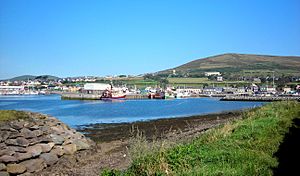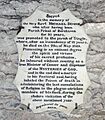Dingle facts for kids
Quick facts for kids
Dingle
Daingean Uí Chúis
|
|
|---|---|
|
Town
|
|

Strand Street, Dingle
|
|
| Country | Ireland |
| Province | Munster |
| County | County Kerry |
| Population
(2022)
|
1,671 |
| Irish Grid Reference | Q445011 |
Dingle (also known as An Daingean or Daingean Uí Chúis in Irish) is a charming town in County Kerry, Ireland. It's the only town on the Dingle Peninsula, sitting right on the Atlantic coast. Dingle is about 50 kilometers (31 miles) southwest of Tralee and 71 kilometers (44 miles) northwest of Killarney.
The main ways people make a living here are through tourism, fishing, and farming. Dingle Mart, a livestock market, helps the local farming community. In 2022, Dingle had a population of 1,671 people. It's also in a Gaeltacht region, which means Irish is spoken daily by many people. For many years, a friendly Bottlenose dolphin named Fungie was famous for interacting with people in Dingle Bay, but he disappeared in 2020.
Contents
Discovering Dingle's Past
Dingle has a long and interesting history. Ancient Ogham stones, which are large stones with early Irish writing, were found nearby. These stones date back to the 4th and 5th centuries AD.
How Dingle Became a Port Town
Dingle grew into an important port after the Norman invasion of Ireland. By the 1200s, more goods were being shipped out of Dingle than even Limerick. In 1257, King Henry III started collecting taxes on goods leaving the port.
By the 1300s, importing wine was a big business in Dingle. The local ruler, the 1st Earl of Desmond, even taxed this activity around 1329. In the 1500s, Dingle was one of Ireland's main trading ports. It exported fish and animal hides and imported wines from Europe. Fishing fleets from France and Spain often used Dingle as their base.
Dingle had strong ties with Spain. In 1529, a special agreement called the Treaty of Dingle was signed here. Dingle was also a popular starting point for pilgrims traveling to a holy site in Spain called Santiago de Compostela. The local church was even rebuilt in the 1500s with "Spanish help" and dedicated to Saint James.
Dingle's Walls and Parliament
In 1569, the people of Dingle asked for money to build walls around their town. After a rebellion, Queen Elizabeth I decided to make Dingle a special town called a borough. This allowed them to build walls and have their own local government. You can still see parts of these old town walls today.
The official document for Dingle to become a borough was signed in 1607 by King James I. This meant Dingle could elect two members to the Irish Parliament.
Linen and Fishing Industries

Dingle faced tough times during various wars, being burned or attacked often. But it started to recover in the 1700s. A local family, the Knights of Kerry, helped set up a successful linen industry. By 1755, they were producing a lot of linen cloth. However, this industry declined when cotton production became popular in Great Britain.
Dingle then became a major fishing port around 1830. In the 1870s, fishing boats from the Isle of Man came to catch mackerel. Later, herring trawlers from England joined them. The harbor facilities were improved, and when the railway arrived in 1891, it became easier to transport fish across the country. This led to the growth of fish canning and curing businesses.
Education in Dingle
Dingle has several schools for young people. There are three primary schools: Scoil An Ghleanna, Scoil Iognáid Rís, and Bunscoil an Clochair. For older students, there are two secondary schools: Pobalscoil Chorca Dhuibhne and Coláiste Íde Boarding School. Since Dingle is a Gaeltacht area, it also hosts Irish language schools for students during the summer.
Sacred Heart University from the USA also has an Irish studies center in Dingle, where students can learn about Irish culture and history.
Fun Places to Visit in Dingle
Dingle is full of interesting places to explore!
Churches and Art
Dingle's St. Mary's Church is a beautiful neo-Gothic church. Its foundation stone was laid in 1862. The Chapel of the Sacred Heart is connected to St. Mary's. It was built in 1886. This chapel is famous for its six stunning stained glass windows. These windows were created in 1924 by the well-known Irish artist Harry Clarke. They show different scenes from the life of Christ.
Entertainment and Local Treats
You can often hear Irish traditional music being played in many places, especially during the summer. Dingle has lots of pubs, restaurants, and cafes where you can enjoy food and music.
The "Oceanworld Aquarium" is a popular spot, home to many different kinds of tropical, foreign, and local sea animals. You'll also find many art and craft shops around town. Dingle is home to Murphy's Ice Cream, which makes delicious ice cream from local Kerry cattle. Another local business is Dingle Distillery, which started in 2012.
Ancient Sites Nearby
Just 3 kilometers (2 miles) east of Dingle, you can find Gallaunmore. This is a large standing stone and a protected National Monument. Also nearby, on Lateeve Hill, is St. Manchan's Oratory. This is a medieval chapel with an ogham stone and an underground passage called a souterrain.
Sports and Activities
Dingle is a great place for sports! It's home to the Dingle GAA club, which has Gaelic football teams. They compete in the Kerry Senior Football Championship. There's also a local rugby team called Rugbaí Chorca Dhuibhne, and a soccer team, Dingle Bay Rovers F.C.
The yearly Dingle Marathon started in 2009. It's a popular event where runners can choose to do a full marathon or a half marathon. The full marathon starts and ends in Dingle town, going around Slea Head and the Dingle Peninsula. The half marathon goes from Dingle to Dun Chaoin. Many people take part in this exciting race each year.
Getting Around Dingle
You can get to and from Dingle by bus. There are bus routes connecting Dingle to Killarney, Tralee, Kerry Airport, and other nearby towns like Cloghane and Ballydavid.
Dingle used to have a narrow-gauge railway line called the Tralee and Dingle Light Railway. It closed in 1953. Today, the closest train station is in Tralee, and you can take a bus from there to Dingle. Buses also run from Killarney train station to Dingle.
The Name of Dingle
Dingle has an interesting story about its name. In 2005, a government minister announced that official road signs in Gaeltacht areas would only show the Irish language names. So, "Dingle" was officially removed from signs, and only An Daingean was used.
This caused some debate because Dingle relies a lot on tourism. People worried that visitors might not recognize the Irish name and get lost. They also worried about confusion with another town called Daingean in County Offaly. However, supporters said that many towns in Ireland have similar names.
Later, in 2006, the local council held a vote to decide the name. Most people voted for the name to be bilingual: "Dingle/Daingean Uí Chúis". In 2011, a law was passed that officially made "Dingle" the English name and "Daingean Uí Chúis" the Irish name. However, road signs within the Gaeltacht still show only the Irish name.
Famous People from Dingle
Many interesting people have come from Dingle, including:
- Daniel Cavanagh, who was a politician in the USA.
- Joe Higgins, a well-known Irish politician.
- Mark O'Connor, an Australian Football League player.
- Joe O'Toole, a Senator.
- Pauline Scanlon, a talented singer.
- All the members of the alternative rock band, Walking on Cars.
- Mícheál Ó Muircheartaigh, a famous Gaelic games commentator.
- Patrick James and Margaret Anna Curran McDonald, who were the parents of Richard and Maurice McDonald, the founders of McDonald's Restaurants.
Images for kids
-
Commemorative plaque to Fr. Michael Divine, a parish priest who helped people during a cholera outbreak in 1849.
See also
 In Spanish: Dingle para niños
In Spanish: Dingle para niños










